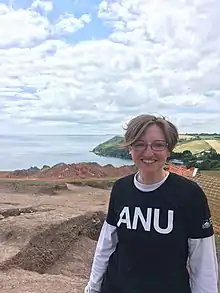Catherine Frieman
Catherine J. Frieman is an archaeologist and associate professor at the Australian National University. Her research investigates conservatism and innovation, and she is a specialist in material culture and technology.[1]
Catherine J. Frieman | |
|---|---|
 Frieman at Talland Round in June 2019 | |
| Occupation | Archaeologist |
| Academic background | |
| Alma mater | |
| Thesis | Skeuomorphs and stone-working : elaborate lithics from the early metal-using era in coastal, northwest Europe (2010) |
| Academic work | |
| Institutions | Australian National University |
Education
She graduated with a BA in archaeological studies from Yale.[2] Frieman completed her MSt and DPhil at the University of Oxford.[3] She held a Rhodes scholarship.[2] Her thesis, completed in 2010, investigated lithic objects from 4th-2nd millennium BC northwest Europe which are commonly considered as skeuomorphs, in order to investigate the adoption of metallurgy and metal objects.
Career
Frieman was appointed as a lecturer at ANU in after having held post-doctoral positions at Oxford, and lecturing at the University of Nottingham.[1] She currently holds an ARC DECRA fellowship for the project Conservatism as a dynamic response to the diffusion of innovations.[4] Frieman has co-edited volumes on flint daggers in prehistoric Europe and Bronze Age coastal archaeology finds in south-west Britain.[5] She is co-editor of the European Journal of Archaeology.[6] She has received teaching excellence awards from CASS, the Australian Office of Learning and Teaching[7] and the ANU Vice-Chancellor's office,[1][8] and has been appointed as an ANU Distinguished Educator.[8]
Frieman is the co-director of the Southeast Kernow Archaeological Survey, which is investigating the Neolithic to later Iron Age period in Cornwall.[1][9][10]
Selected publications
- Frieman, C 2012. Going to pieces at the funeral: Completeness and complexity in early Bronze Age jet 'necklace' assemblages. Journal of Social Archaeology 12(3): 334–355.
- Frieman, C 2014. Double Edged blades : re-visiting the British (and Irish) flint daggers. Proceedings of the Prehistoric Society 80: 33–65.
- Frieman, C & Eriksen, B, eds, 2015. Flint Daggers in Prehistoric Europe. Oxford: Oxbow Books.
- Frieman, C, Bruck, J, Rebay-Salisbury, K et al. 2017. Aging Well: Treherne's 'Warrior's Beauty' Two Decades Later. European Journal of Archaeology 20(1): 36 – 73.
- Frieman, C, Piper, P, Nguyen, K et al. 2017. Rach Nui: Ground stone technology in coastal Neolithic settlements of southern Vietnam. Antiquity 91 (358): 933–946.
- Frieman, C & Janz, L 2018. A Very Remote Storage Box Indeed: The Importance of Doing Archaeology with Old Museum Collections. Journal of Field Archaeology 43(4): 257–268.
References
- Director (Research Services Division). "Dr Catherine J. Frieman". researchers.anu.edu.au. Retrieved 2019-08-18.
- "Catherine Frieman Profiles". The Rhodes Project. Retrieved 2019-09-05.
- Frieman, C. "Skeuomorphs and stone-working : elaborate lithics from the early metal-using era in coastal, northwest Europe". solo.bodleian.ox.ac.uk. Retrieved 2019-08-18.
- Director (Research Services Division). "Conservatism as a dynamic r..." researchers.anu.edu.au. Retrieved 2019-08-18.
- Needham, Stuart (2013). Claimed by the sea : Salcombe, Langdon Bay, and other marine finds of the Bronze Age. Parham, Dave,, Frieman, Catherine, 1982-. York. ISBN 9781902771953. OCLC 846787158.
- "Editorial board". Cambridge Core. Retrieved 2019-08-18.
- "2015 Australian Awards for University Teaching" (PDF).
- "Dr Catherine Frieman". ANU. 2018-03-21. Retrieved 2019-08-18.
- "Bronze Age 'burial pot' uncovered". 2018-04-17. Retrieved 2019-09-05.
- "4,000-Year-Old Urn Discovered in England – Archaeology Magazine". www.archaeology.org. Retrieved 2019-09-05.